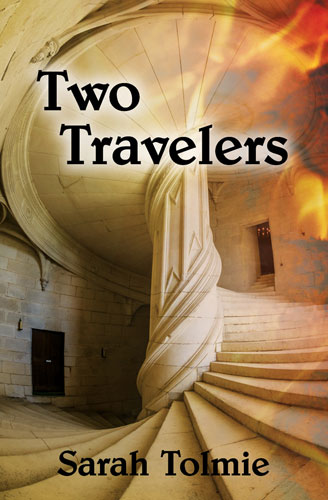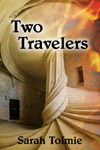

Two Travelers is available in trade paperback and ebook from
Two Travelers comprises two stories. In “Dancer on the Stairs,” a woman wakes up on a stone staircase in a baroque palace, not speaking the language of the place and lacking the chemical signature that allows people to identify each other within a complex social hierarchy. Unable to communicate in words, she resorts to dance. In “The Burning Furrow,” a man who runs a diner in present-day America is also a freedom-fighter in the northern, courtly realm of Dinesen. His people are abused foreigners at home, the servants of strangers, bound not by their overlords, but by their world itself, through a ritual known as the burning of the furrows. Only he and his family are free—for a time. Now that time is ending.
Reprint
“The Dancer on The Stairs,” is reprinted in Strange Horizons 28 November 2016.
This issue also features a podcast of “The Dancer on The Stairs,” read by Anaea Lay, and an interview with Sarah Tolmie by Maureen Kincaid Speller.
Advance Praise
A. M. Dellamonica, author of A Daughter of No Nation and The Nature of a Pirate
Two Travelers is a magical evocation of the outsider experience, a book that transports its characters to strange new worlds, where they must make their way despite language barriers and culture shock. Sarah Tolmie’s lyrical prose guides readers through vividly imagined cultures where the fate of a kingdom hangs on the outcome of a dance, or where, as your family's size changes, so too must your name.
Amy Thomson, author of Storyteller and The Color of Distance
Sarah Tolmie is one of the best new writers I’ve discovered in a long time. Her writing is a joy to read.
Reviews
Publishers Weekly (starred review)
Author and professor Tolmie (The Stone Boatmen) delivers an exquisite duo of short stories in this slim volume. “The Dancer on the Stairs” follows a woman who is trapped on a staircase between hallways, each an individual region unto itself. A rover of sorts, the woman is unable to communicate with those who call the hallways their home. Only by dancing does she create a strong foothold in this new world, while courting a prince who shares her limitations. “The Burning Furrow” tells of a Romany family who move between worlds and whose honor and destiny depend on the rituals surrounding their names. Rich with detail, both stories are imbued with baroque sensibilities, a refreshing deviation from the typical medieval setting. Rather than relying on pure exposition, Tolmie uses the characters’ interactions and personalities to bring color to the unique magic of each setting. Tolmie’s investigations of identity, place, and personal meaning are a delight to read and a great contribution to the genre.